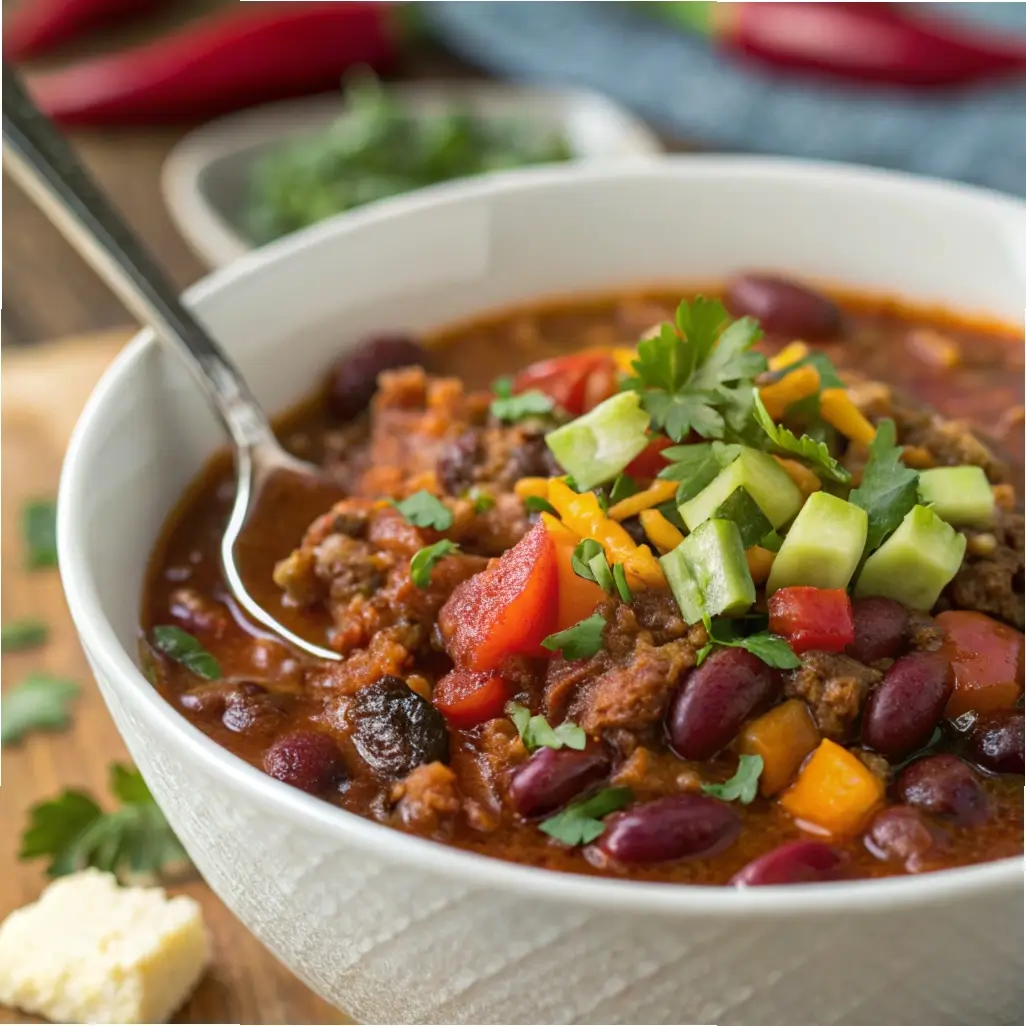Contents
When it comes to heart-healthy eating, controlling sodium intake is a top priority. Excess salt can contribute to high blood pressure, increasing the risk of heart disease and stroke. But reducing sodium doesn’t mean giving up on flavor. This Low Sodium Chili Recipe is proof that a delicious, comforting chili can be packed with herbs, spices, and fresh ingredients — all without the salt overload.
Perfect for those managing hypertension, following a clean eating plan, or anyone who simply wants a tasty, nourishing bowl of chili without the extra sodium. This recipe is also dietitian-approved, making it an excellent choice for health-conscious eaters.
Let’s dive into this colorful, hearty, and heart-friendly chili!
Why Choose Low Sodium Chili?
-
Supports Heart Health: Lowering sodium helps maintain healthy blood pressure levels.
-
Packed with Nutrients: Beans, veggies, and lean protein offer fiber, vitamins, and minerals.
-
Satisfies Cravings: Bold spices and fresh herbs add rich flavor without salt.
-
Flexible & Easy: Great for meal prep, weeknight dinners, and freezing.
Ingredients
Protein
-
1 lb lean ground turkey or chicken (choose lean for heart health)
-
OR 1 can (15 oz) no-salt-added black beans or kidney beans, drained and rinsed
Vegetables
-
1 large onion, diced
-
3 cloves garlic, minced
-
1 green bell pepper, diced
-
1 red bell pepper, diced
-
1 cup diced carrots (adds sweetness and fiber)
-
1 (14.5 oz) can no-salt-added diced tomatoes
-
1 (6 oz) can no-salt-added tomato paste
Liquids & Broth
-
1 cup low-sodium vegetable or chicken broth (make your own or find low-sodium brands)
Herbs & Spices (No Salt Needed!)
-
2 tbsp chili powder (check sodium content on brands)
-
1 tbsp ground cumin
-
1 tsp smoked paprika
-
1 tsp dried oregano
-
½ tsp black pepper
-
1 tsp ground coriander (optional for brightness)
-
½ tsp crushed red pepper flakes (optional for heat)
Fresh Herbs & Extras
-
Juice of 1 lime (brightens flavor)
-
¼ cup chopped fresh cilantro or parsley (for garnish)
-
Sliced avocado or diced tomatoes (optional toppings)
Step-by-Step Instructions
1. Prepare Your Ingredients
Wash and dice all vegetables. Mince garlic and chop fresh herbs. Drain and rinse canned beans thoroughly to reduce sodium further.
2. Cook the Protein
In a large non-stick pot or Dutch oven, brown the ground turkey or chicken over medium heat until fully cooked and no longer pink. Use a spoon to break up the meat into crumbles. Remove excess fat by blotting with paper towels if needed.
3. Sauté the Veggies
Add diced onion, garlic, bell peppers, and carrots to the pot. Cook for 5–7 minutes until veggies soften and onions become translucent.
4. Add Tomatoes and Spices
Stir in diced tomatoes, tomato paste, and all the spices — chili powder, cumin, paprika, oregano, black pepper, coriander, and red pepper flakes if using. Mix well to combine.
5. Pour in Broth and Beans
Add low-sodium broth and the rinsed beans. Stir everything thoroughly. Bring the mixture to a simmer over medium heat.
6. Simmer and Let Flavors Meld
Reduce heat to low, cover partially with a lid, and let simmer gently for 30–40 minutes, stirring occasionally. This slow simmer lets the flavors develop deeply without any added salt.
7. Finish with Fresh Ingredients
Just before serving, squeeze in fresh lime juice and stir. Garnish with chopped cilantro or parsley and optional avocado slices or fresh tomato chunks.
Tips for Maximizing Flavor Without Salt
-
Use Fresh Garlic and Onions: These provide natural savory depth.
-
Roast Your Veggies: Charred peppers and tomatoes add smoky complexity.
-
Incorporate Acid: Lime juice or a splash of vinegar brightens flavors.
-
Add Umami-Rich Ingredients: Mushrooms, a dash of low-sodium soy sauce, or nutritional yeast can add richness.
-
Double Up on Herbs: Fresh cilantro or parsley at the end enhances aroma and taste.
Nutritional Benefits
-
Low in Sodium: Using no-salt-added products and fresh spices keeps sodium levels in check.
-
High Fiber: Beans and vegetables promote digestive health and sustained energy.
-
Lean Protein: Ground turkey or chicken supports muscle maintenance without excess fat.
-
Rich in Antioxidants: Tomatoes, peppers, and spices fight inflammation and support heart health.
Meal Prep & Storage
-
Refrigerate: Store chili in an airtight container for up to 4 days.
-
Freeze: Portion into freezer-safe containers and freeze for up to 3 months. Defrost overnight in the fridge before reheating.
-
Reheat: Warm on the stove over low heat or in the microwave, stirring occasionally.
Frequently Asked Questions (FAQs)
Can I use ground beef instead of turkey or chicken?
Yes, but opt for lean ground beef (90% lean or higher) to keep saturated fat low for heart health.
Are canned beans okay on a low sodium diet?
Choose no-salt-added or low-sodium canned beans and rinse them thoroughly under cold water to remove residual sodium.
Can I make this recipe vegetarian or vegan?
Absolutely! Simply omit the meat and increase beans or add lentils for protein. Use vegetable broth instead of chicken broth.
What if I don’t have all the spices?
Chili powder and cumin are the most essential. You can omit coriander or red pepper flakes if needed, but they add nice depth.
Is this recipe spicy?
It’s mildly spicy by default. Add more crushed red pepper or fresh jalapeños to increase heat.
Why This Recipe Is a Heart-Healthy Winner
This chili offers all the hearty comfort you expect from a classic chili but reimagined with heart health in mind. It relies on natural herbs, fresh ingredients, and no added salt to deliver robust flavor that satisfies the palate without compromising your well-being. Whether you’re managing hypertension or simply eating clean, this recipe will become a staple in your kitchen.





